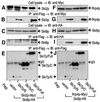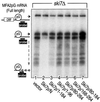Ski7p G protein interacts with the exosome and the Ski complex for 3'-to-5' mRNA decay in yeast
- PMID: 11532933
- PMCID: PMC125587
- DOI: 10.1093/emboj/20.17.4684
Ski7p G protein interacts with the exosome and the Ski complex for 3'-to-5' mRNA decay in yeast
Abstract
Two cytoplasmic mRNA-decay pathways have been characterized in yeast, and both are initiated by shortening of the 3'-poly(A) tail. In the major 5'-to-3' decay pathway, the deadenylation triggers removal of the 5'-cap, exposing the transcript body for 5'-to-3' degradation. An alternative 3'-to-5' decay pathway also follows the deadenylation and requires two multi-complexes: the exosome containing various 3'-exonucleases and the Ski complex consisting of the RNA helicase Ski2p, Ski3p and Ski8p. In addition, Ski7p, which has an N-terminal domain and a C-terminal elongation factor 1alpha-like GTP-binding domain, is involved in the 3'-to-5' decay. However, physical interaction between the exosome and the Ski complex, together with the function of Ski7p, has remained unknown. Here we report that the N domain of Ski7p is required and sufficient for the 3'-to-5' decay. Furthermore, the exosome and the Ski complex interact with the different regions of Ski7p N domain, and both interactions are required for the 3'-to-5' decay. Thus, Ski7p G protein appears to function as a signal-coupling factor between the two multi-complexes operating in the 3'-to-5' mRNA-decay pathway.
Figures








References
-
- Adams A., Gottschling,D.E., Kaiser,C.A. and Stearns,T. (1997) Methods in Yeast Genetics. Cold Spring Harbor Laboratory Press, Cold Spring Harbor, NY.
Publication types
MeSH terms
Substances
LinkOut - more resources
Full Text Sources
Molecular Biology Databases
Miscellaneous

